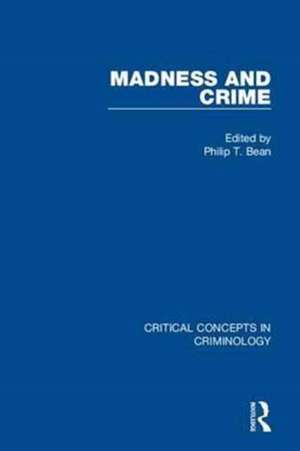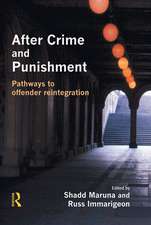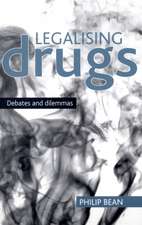Madness and Crime: Critical Concepts in Criminology
Editat de Philip Beanen Limba Engleză Hardback – 24 noi 2016
As serious research on and around madness and crime continues to flourish, this new four-volume collection from Routledge’s Critical Concepts in Criminology series addresses these and other questions. Indeed, Madness and Crime provides an authoritative and highly readable anthology of major works, compiled by one of the leading authorities in the field.
Din seria Critical Concepts in Criminology
- 34%
 Preț: 5487.80 lei
Preț: 5487.80 lei - 34%
 Preț: 6740.00 lei
Preț: 6740.00 lei - 34%
 Preț: 6734.68 lei
Preț: 6734.68 lei - 34%
 Preț: 6731.84 lei
Preț: 6731.84 lei - 34%
 Preț: 6744.08 lei
Preț: 6744.08 lei - 34%
 Preț: 6737.55 lei
Preț: 6737.55 lei - 34%
 Preț: 5344.13 lei
Preț: 5344.13 lei - 34%
 Preț: 6183.69 lei
Preț: 6183.69 lei - 34%
 Preț: 5487.39 lei
Preț: 5487.39 lei - 34%
 Preț: 3683.85 lei
Preț: 3683.85 lei - 34%
 Preț: 5207.41 lei
Preț: 5207.41 lei - 34%
 Preț: 7021.62 lei
Preț: 7021.62 lei - 33%
 Preț: 2008.41 lei
Preț: 2008.41 lei - 34%
 Preț: 6743.26 lei
Preț: 6743.26 lei - 34%
 Preț: 7020.79 lei
Preț: 7020.79 lei - 34%
 Preț: 6456.74 lei
Preț: 6456.74 lei - 34%
 Preț: 6179.20 lei
Preț: 6179.20 lei
Preț: 5912.03 lei
Preț vechi: 8943.76 lei
-34% Nou
Puncte Express: 8868
Preț estimativ în valută:
1131.28€ • 1184.12$ • 941.57£
1131.28€ • 1184.12$ • 941.57£
Comandă specială
Livrare economică 10-24 martie
Doresc să fiu notificat când acest titlu va fi disponibil:
Se trimite...
Preluare comenzi: 021 569.72.76
Specificații
ISBN-13: 9781138962002
ISBN-10: 1138962007
Pagini: 2040
Dimensiuni: 156 x 234 mm
Greutate: 3.46 kg
Ediția:1
Editura: Taylor & Francis
Colecția Routledge
Seria Critical Concepts in Criminology
Locul publicării:Oxford, United Kingdom
ISBN-10: 1138962007
Pagini: 2040
Dimensiuni: 156 x 234 mm
Greutate: 3.46 kg
Ediția:1
Editura: Taylor & Francis
Colecția Routledge
Seria Critical Concepts in Criminology
Locul publicării:Oxford, United Kingdom
Public țintă
Postgraduate and UndergraduateCuprins
Madness and Crime: Critical Concepts in Criminology
Edited by Philip T. Bean
Volume 1
Contents
Acknowledgements
Preface
Introduction
Part 1. Madness, Crime and Compulsion
Edited by Philip T. Bean
Volume 1
Contents
Acknowledgements
Preface
Introduction
Part 1. Madness, Crime and Compulsion
- P. T. Bean, ‘Some Methodological Problems in the Madness and Crime Nexus’, in Madness and Crime (Willan, 2008), pp. 123-127.
- P. T. Bean, ‘A Model for Examining the Links between Madness (Mental Disorder) and Crime’, in Madness and Crime (Willan, 2008), pp. 139- 184.
- P. Fennell, ‘The Law Relating to Mentally Disordered Persons in the Criminal Justice System’, in K. Soothill, P. Rogers and M. Dolan (eds), Handbook of Forensic Mental Health (Willan, 2008), pp. 291-327
- M. Vogel, K. Stephens and D. Siebels, ‘Mental Illness and the Criminal Justice System’, Sociology Compass 8, 6, 2014, 627-638.
- A. L. S. Brandt, ‘Treatment of Persons with Mental Illness in the Criminal Justice System: A Literature Review’, Journal of Offender Rehabilitation 51, 8, 2012, 541-558
- J. Peay, ‘Are Mental Health and Crime Related?’, in Mental Health and Crime (Routledge, 2010), pp. 33-43.
- J. Peay, ‘Types of Crime’, in Mental Health and Crime (Routledge, 2010), pp. 44-51.
- T. Amos et al., ‘The Majority of Crime: Theft, Motoring and Criminal Damage (Including Arson)’, in J. Gunn and P. Taylor (eds), Forensic Psychiatry: Clinical Legal and Ethical Issues, 2nd ed (CRC Press, 2014), pp 266-282.
- H. Prins, ‘Psychopathic Disorder - Concept or Chimera’, Journal of Mental Health Law December, 2002, 247-261.
- P. J. Taylor, ‘Schizophrenia and Crime: Distinctive Patterns in Association’, in S. Hodgins (ed.), Mental Disorder and Crime (Sage, 1993), pp. 63-85.
- J. Gunn, ‘Criminal Behaviour and Mental Disorder’, British Journal of Psychiatry 130, 4, 1977, 317-329
- J. Monahan et al, ‘Coercion and Commitment: Understanding Involuntary Mental Hospital Admission’, International Journal of Law and Psychiatry 18, 3, 1995, 249-263.
- G. Hoyer, ‘On the Justification for Civil Commitment’, Acta Psychiatrica Scandinavica 101, 2000, 65-71
- S. Priebe et al, ‘Patients` Views and Readmissions 1 Year after Involuntary Hospitalisation’, The British Journal of Psychiatry 194, 2009, 49-54.
Volume 2
Contents
Acknowledgements
Part 2. Madness, Crime and Violence - B. G. Link, H. Andrews and F. Cullen, ‘The Violent and Illegal Behaviour of Mental Patients Reconsidered’, American Sociological Review 57 1992, 275-292.
- J. Monahan, ‘Mental Disorder and Violence: Another Look’, in S. Hodgins (ed.), Mental Disorder and Crime (Sage, 1993), pp. 287-302.
- P. Bowden, ‘Violence and Mental Disorder’, in N. Walker (ed.), Dangerous People (Blackstone Press, 1996), pp. 13-27.
- P. Taylor et al. ‘Delusions and Violence’, J. Monaghan and H. Steadman (eds), Violence and Mental Disorder (University of Chicago Press, 1996), pp. 161-182.
- H. Steadman et al., ‘Violence by People Discharged from Acute Psychiatric Inpatient Facilities and by Others in the Same Neighbourhoods’, Archives General Psychiatry 55,5, 1998, 393-401.
- V. A. Hiday et al. ‘Victimization: A Link between Mental Illness and Violence?’, International Journal of Law and Psychiatry 24, 2001, 559-572.
- S. Hodgins et al., ‘Aggressive Behaviour, Victimisation and Crime among Severely Mentally Ill Patients Requiring Hospitalisation’, British Journal of Psychiatry 191, 2007, 343-350.
- M. Wheatley, ‘The Prevalence and Relevance of Substance Use in Detained Schizophrenic Patients’, Journal of Forensic Psychiatry 9, 1, 1998, 114-129
- L. Teplin, ‘Psychiatric and Substance Abuse Disorders among Male Urban Jail Detainees’, American Journal of Public Health 84, 2, 1994, 290-293.
- N. Seivewright, M. Z. Iqbal and H. Bourne, ‘Treating Patients with Comorbidities’, in P. Bean and T. Nemitz (eds), Drug Treatment: What Works? (Routledge, 2004), pp. 123-141.Part 3. Legal Defences
- R. D. Mackay, ‘Diminished Responsibility and Mentally Disordered Killers’, in A. Ashworth and P. Mitchell (eds), Rethinking English Homicide Law (Oxford University Press, 2000), pp. 55- 83.
- D. Grubin, ‘What Constitutes Fitness to Plead?’, Criminal Law Review 1993, 748-758.
- D. Grubin, ‘Unfit to Plead in England and Wales 1976-1988: A Survey’, British Journal of Psychiatry 158, 1991, 540 -548.
- J. Peay, ‘Fitness to Plead and Core Competencies: Problems and Possibilities’, LSE Law, Society and Economy Working Papers 2/2012 pp. 1-30.
- T. P. Rogers et al., ‘Fitness to Plead and Competence to Stand Trial: A Systematic Review of the Constructs and their Application’, Journal of Forensic Psychiatry and Psychology 19, 4, 2008, 576- 596
- T. Ward, ‘A Terrible Responsibility: Murder and the Insanity Defence in England, 1908-1939’, International Journal of Law and Psychiatry 25, 2002, 361-377.
- R. D. Mackay, B. J. Mitchell and L. Howe, ‘Yet More Facts about the Insanity Defence’, Criminal Law Review 2006, 399-411.
- D. Ormerod, ‘The Law Commission`s Proposals for the Reform of the Defences of Insanity and Automatism’, Medicine Science and the Law 55, 3, 2015, 156-161.
- R. D. Mackay, ‘An Anatomy of Automatism’, Medicine Science and the Law 55, 3 2015, 150-155.
- M. D. Dubber, ‘The Model Penal Code, Legal Process, and the Alegitimacy of American Penality’, Foundation Texts in Modern Criminal Law (Oxford University Press, 2013), pp. 1-25.
- P. H. Robinson and M. D. Dubber, ‘The American Penal Code: A Brief Overview’, New Criminal Law Review 10, 3, 2007, 319- 341.
- J. Peay, ‘Mental Incapacity and Criminal Responsibility: Redrawing the Fault Lines?’, International Journal of Law and Psychiatry 40, 20105, 25-35.
- I. Quarshi and J. Shaw, ‘Sections 37/41 Mental Health Act 1983: A Study of Judge`s Practice and Assessment of Risk to the Public’, Medicine Science and the Law 48, 2008, 57-63.
- P. S. Appelbaum, ‘Law and Psychiatry: Behavioral Genetics and the Punishment of Crime’, Psychiatric Services 6, 1, 2005, 25-27.
Volume 3
Contents
Acknowledgements
Part 4. The Police, the Courts and the Mentally Disordered Offenders - M. Docking, ‘The Use of Section 136 to Detain People in Police Stations’, Journal of Mental Health Law 18, 2009, 33-44.
- T. Fahy, ‘The Police as a Referral Agency for Psychiatric Emergencies – A Review’, Medicine Science and the Law 29, 4, 1989, 315- 321.
- L. Teplin and N. Pruett, ‘Police as Streetcorner Psychiatrist: Managing the Mentally Ill’, International Journal of Law and Psychiatry 15, 1992, 139- 156.
- G. P. Alpert, R. G. Durham and John M. MacDonald, ‘Interactive Police-Citizen Encounters that Result in Force’, Police Quarterly 7, 4, 2004, 475-488.
- M. S. Morabito and K. M. Socia, ‘Is Dangerousness a Myth? Injuries and Police Encounters with People with Mental Illnesses’, Criminology and Public Policy 14, 2, 2015, 253-276.
- J. L. S. Teller et al., ‘Crisis Intervention Team Training for Police Officers Responding to Mental Disturbance Calls’, Psychiatric Services 57, 2, 2006, 232-237.
- A. C. Watson and A. J. Fulambarker, ‘The Crisis Intervention Team Model of Police Response to Mental Health Crises: A Primer for Mental Health Practitioners’, Best Practice Mental Health 8, 2 2012, pp 1-8.
- G. Gudjonsson et el., ‘Custodial Interrogation, False Confession and Individual Differences: A National Study among Icelandic Youth’, Personality and Individual Differences 41, 2006, 49-59.
- A. D. Redlich, A. Summers and S. Hoover, ‘Self-reported False Confessions and False Guilty Pleas among Offenders with Mental Illness’, Law and Human Behaviour 39, 2010, 79-90.
- T. Nemitz and P. Bean, ‘Protecting the Rights of the Mentally Disordered in Police Stations: The Use of the Appropriate Adult in England and Wales’, International Journal of Law and Psychiatry 24, 2001, 595-605.
- M. R. Kebbell, C. Hatton and S. D. Johnson, ‘Witnesses with Intellectual Disabilities in Court: What Questions are Asked and What Influence Do They Have?’, Legal and Criminological Psychology 9, 1, 2004, 23-35.
- N. Padfield, ‘Bailing and Sentencing the Dangerous’, N. Walker (ed.), Dangerous People (Blackstone Press, 1996), pp. 70- 94.
- J. Gunn, A. Ridley and K. Rix, ‘Psychiatric Reports for Legal Purposes in England and Wales’, in J. Gunn and P. Taylor (eds), Forensic Psychiatry: Clinical Legal and Ethical Issues 2nd ed. (CRC Press, 2014), pp 148-169.
- G. Mellsop, D. Fraser, R. Tapsell and D. Menkes, ‘Courts` Misplaced Confidence in Psychiatric Diagnoses’, International Journal of Law and Psychiatry 34, 2011, 331-335.
- J. O`Grady, ‘Psychiatry and Ethics in UK Criminal Sentencing’, in A. Buchanan and M. A. Norko (eds), The Psychiatric Report (Cambridge University Press, 2011), pp. 254-263.
- N. Eastman et al., ‘The Psychiatrist Courts and Sentencing: The Impact of Extended Sentencing on the Ethical Framework of Forensic Psychiatry’, British Journal Psychiatry Bulletin 29, 2 2004, 73-77.
- A. Stone, ‘The Ethical Boundaries of Forensic Psychiatry: A View from the Ivory Tower’ Journal of the American Academy of Psychiatry Law 36, 2008, 167-174.Part 5. The mentally disordered offender in custody
- ONS (authors N. Singleton et el.), ‘Survey of Psychiatric Morbidity among Prisoners in England and Wales’, (Government Statistical Service, 1997), pp. 1-29.
- M. Farrell et al., ‘Psychoses and Drug Dependence: Results from a National Survey of Prisoners’, British Journal of Psychiatry, 181, 2002, 393-398.
- J. Coid et al. ‘The National Survey of Psychiatric Morbidity Among Prisoners and the Future of Prison Healthcare’, Medicine Science and the Law 42, 3, 2002, 245-250.
- Social Exclusion Unit, ‘Mental and Physical Health’, Reducing Reoffending by Ex-prisoners (Office of the Deputy Prime Minister, 2002), pp. 68-73.
- S. Parsons, L. Walker and D. Grubin, ‘Prevalence of Mental Disorder in Female Remand Prisoners’, Journal of Forensic Psychiatry 12, 1, 2001, 194-202
- H. J. Steadman et al., ‘Prevalence of Serious Mental Illness Among Jail Inmates’, Psychiatric Services 60, 2009, 761-765.
- T. Grisso, ‘Reasons for Concern About Mental Disorders of Adolescent Offenders in Double Jeopardy’, in Adolescent Offenders with Mental Disorder (University of Chicago Press, 2006), pp. 3-26.
- H. Daniel Butler, W. Wesley Johnson and O. Hayden Griffin III, ‘The Treatment of the Mentally Ill in Supermax Facilitities: An Evaluation of State Supermax Policies’, Criminal Justice and Behaviour 41, 11 2014, 1338-1353.
- D. Mears, ‘Supermax Prisons: The Policy and the Evidence’, Criminology and Public Policy 12, 4, 2013, 681-719.
- E. Genders and E. Player, ‘Therapy in Prison; Revisiting Grendon 20 years on. The Howard Journal 49, 5, 2010, 431-450.
- E. M. Gallagher, ‘Elders in Prison. Health and Wellbeing of Older Inmates’, International Journal of Law and Psychiatry 24, 2001, 325-333.
- D. Pratt et al., ‘Suicide in Recently Released Prisoners: A Population-based Cohort Study’, The Lancet 368, 2006, 119-123.
- L. Wacquant, ‘Deadly Symbiosis: When Ghetto and Prison Meet and Clash’, Punishment and Society 3, 1, 2010, 95-133.
Volume 4
Contents
Acknowledgements
Part 6. The mentally disordered offender in the Community - K. Gledhill, ‘Community Treatment Orders’, Journal of Mental Health Law 16, 2007, 149-169.
- J. Dawson, ‘Fault-lines in Community Treatment Order Legislation’, International Journal of Law and Psychiatry 29, 2006, 482-494.
- S. Lawton-Smith, J. Dawson and T. Burns, ‘Community Treatment Orders Are Not a Good Thing’, The British Journal of Psychiatry 193, 2008, 96-100.
- T. Burns, ‘The Dog that Failed to Bark’, The Psychiatrist 34, 2010, 361-363.
- M. R. Munetz, P. A. Galon and F. J. Frese III, ‘The Ethics of Mandatory Community Treatment’, Journal of American Academy Psychiatry and Law 31, 2003, 173-183.
- A. Gibbs, ‘Coping with Compulsion: Women`s Views of Being On a Community Treatment Order’, Australian Social Work 63. 2, 2010, 223-233.
- T. Burns, et al., ‘Community Treatment Orders for Patients with Psychosis (OCTET): A Randomised Controlled Trial’, The Lancet 381, 2013, 1627-1633.
- J. Rugkasa, ‘Effectiveness of Community Treatment Orders: The International Evidence’, The Canadian Journal of Psychiatry 61, 1, 2016, 15-24.
- J. Rugkasa and J. Dawson, ‘Community Treatment Orders: Current Evidence and the Implications’, British Journal of Psychiatry 203, 2013, 406-408.
- D. Maughan et al., ‘A Systematic Review of the Effect of Community Treatment Orders on Service Use’, Social Psychiatry 49, 2014, 651-663.
- M. S. Swartz and J. W. Swanson, ‘Involuntary Outpatient Commitment, Community Treatment Orders, and Assisted Outpatient Treatment: What`s in the Data?’, Canadian Journal of Psychiatry 49, 9, 2004, 585-591.
- J. Monahan, M. Swartz and R. J. Bonnie, ‘Mandated Treatment in the Community for People with Mental Disorders’, Health Affairs 22, 5, 2003, 28-38
- R. J. Bonnie and J. Monahan, ‘From Coercion to Contract: Reframing the Debate on Mandated Community Treatment for People with Mental Disorders’, Law and Human Behavior 29, 4, 2005, 485-503.
- C. Brooker et al., ‘Probation and Mental Illness’, Journal of Forensic Psychiatry and Psychology 23, 4, 2012, 522-537.
- J. Judge, M.-A. Harty and T. Fahy, ‘Survey of Community Forensic Psychiatry Services in England and Wales’, Journal of Forensic Psychiatry and Psychology 15, 2, 2004, 244-253.
- M. Clarke et al., ‘The Characteristics and Course After Discharge of Mentally Disordered Homicide and Non-homicide Offenders’, Homicide Studies 20, 1, 2016, 80-97.
- J. Coid et al., ‘Psychiatric Diagnosis and Differential Risks of Offending Following Discharge’, International Journal of Law and Psychiatry 38, 2015, 68-74.Part 7. Diversion
- H. J. Steadman et al., ‘Effect of Mental Health Courts on Arrest and Jail Days: A Multisite Study’, Archives of General Psychiatry 68, 2, 2011, 167-172.
- A. D. Redlich et al., ‘The Use of Mental Health Court Appearances in Supervision’, International Journal of Law and Psychiatry 33, 2010, 272-277.
- A. D. Redlich et al. ‘Patterns of Practice in Mental Health Courts: A National Survey’, Law and Human Behaviour 30, 2006, 347–362.
- D. E. McNiel and R. L. Binder, ‘Effectiveness of a Mental Health Court in Reducing Criminal Recidivism and Violence’, The American Journal of Psychiatry 164, 2007, 1395-1403.
- M. E. Moore and V. Hiday, ‘Mental Health Court Outcomes: A Comparison of Re-arrest and Re-arrest Severity between Mental Health Court and Traditional Court Participants’, Law and Human Behaviour 30, 2006, 659-674
- B. Ray, S. P. Kubiak, E. B. Comartin and E. Tillander, ‘Mental Health Court Outcomes by Offense Type at Admission’, Administration and Policy in Mental Health 42, 2015, 323-331.
- A. D. Redlich et al., ‘Is Diversion Swift? Comparing Mental Health Courts and Traditional Criminal Justice Processing’, Criminal Justice and Behaviour 39, 2012, 420-433.
- D. V. James, ‘Diversion of Mentally Disordered People from the Criminal Justice System in England and Wales: An Overview’, International Journal of Law and Psychiatry 33, 2010, 241-248.
- D. Scott et al., ‘Effectiveness of Criminal Justice Liaison and Diversion Services for Offenders with Mental Disorders: A Review’, Psychiatric Services 64, 9, 2013, 843- 849.
- H. J. Steadman et al., ‘Comparing Outcomes of Major Models of Police Responses to Mental Health Emergencies’, Psychiatric Services 51, 5, 2000, 645- 649.Part 8. Treatment or control
- S. Hodgins and R. Muller-Isberner, ‘Treatment Components that may Provide a Base for Developing Effective Treatment Programmes’, in S. Hodgins and R. Muller-Isberner (eds), Violence, Crime and Mentally Disordered Offenders (John Wiley, 2000), pp. 17- 38.
- L. Castells-Aulet et al., ‘Impact of Involuntary Out-patient Commitment on Reducing Hospital Services: 2 Year Follow Up’, Psychiatric Bulletin 39, 2015, 196-199.
- P. J. Taylor and J. Gunn, ‘Diagnosis, Medical Models and Formulations’, in K. Soothill, P. Rogers and M. Dolan (eds), Handbook of Forensic Mental Health (Willan, 2008), pp. 227-243.
- P. T. Bean, ‘Consent and Treatment’, in Mental Disorder and Legal Control (Cambridge University Press, 1986), pp. 129-150.
- J. Peay, ‘Personality Disorder and the Law: Some Awkward Questions’, Philosophy Psychiatry and Psychology 18, 3, 2011, 231-244
- E. Perkins et al., ‘Physical Restraint in a Therapeutic Setting: A Necessary Evil?’, International Journal of Law and Psychiatry 35, 2012, 43-49.
- J. Gunn, ‘Abuse of Psychiatry’, Criminal Behaviour and Mental Health, 16, 2006, 77-86.
- G. Griffin and M. J. Jenuwine, ‘Using Therapeutic Jurisprudence to Bridge the Juvenile Justice and Mental Health Systems’, Scholarly Works. Paper 452, 2002, 65-87.
- J. W. Swanson et al., ‘Preventing Gun Violence Involving People with Serious Mental Illness’, in D. Webster and J. Vernick (eds), Reducing Gun Violence in America (Johns Hopkins University Press, 2013), pp. 33-51.
- B. Hale, ‘Justice and Equality in Mental Health Law: The European Experience’, International Journal of Law and Psychiatry 30, 2007, 18-28.
Descriere
Madness raises intriguing—and complex—criminological questions, not least the famous trio of ‘triability, responsibility, and punishability’. As serious research on and around madness and crime continues to flourish, this new four-volume collection from Routledge’s Critical Concepts in Criminology series addresses these and other questions. Indeed, Madness and Crime provides an authoritative and highly readable anthology of major works, compiled by one of the leading authorities in the field.
Notă biografică
Philip Bean is Emeritus Professor of Criminology and Criminal Justice at Loughborough University, and a former Director of the Midlands Centre for Criminology and Criminal Justice.


















